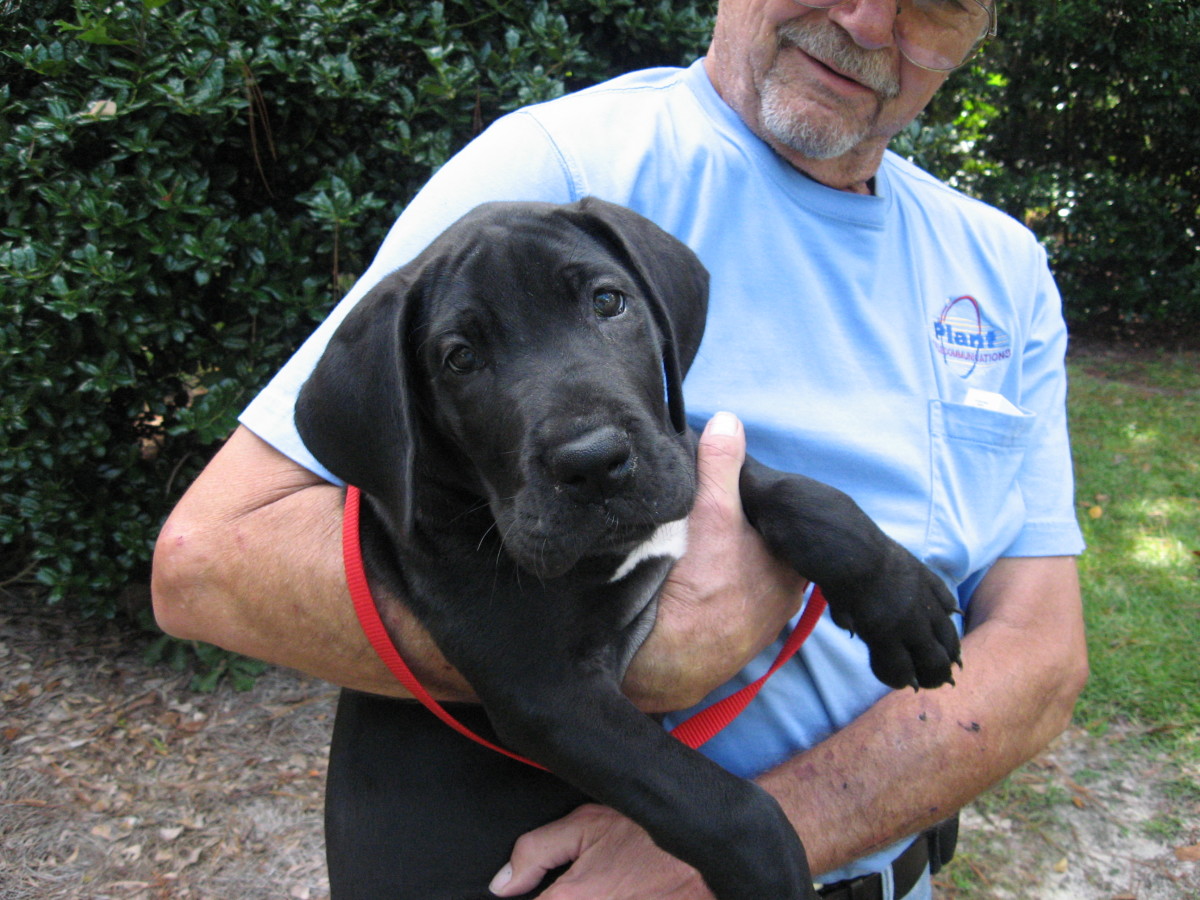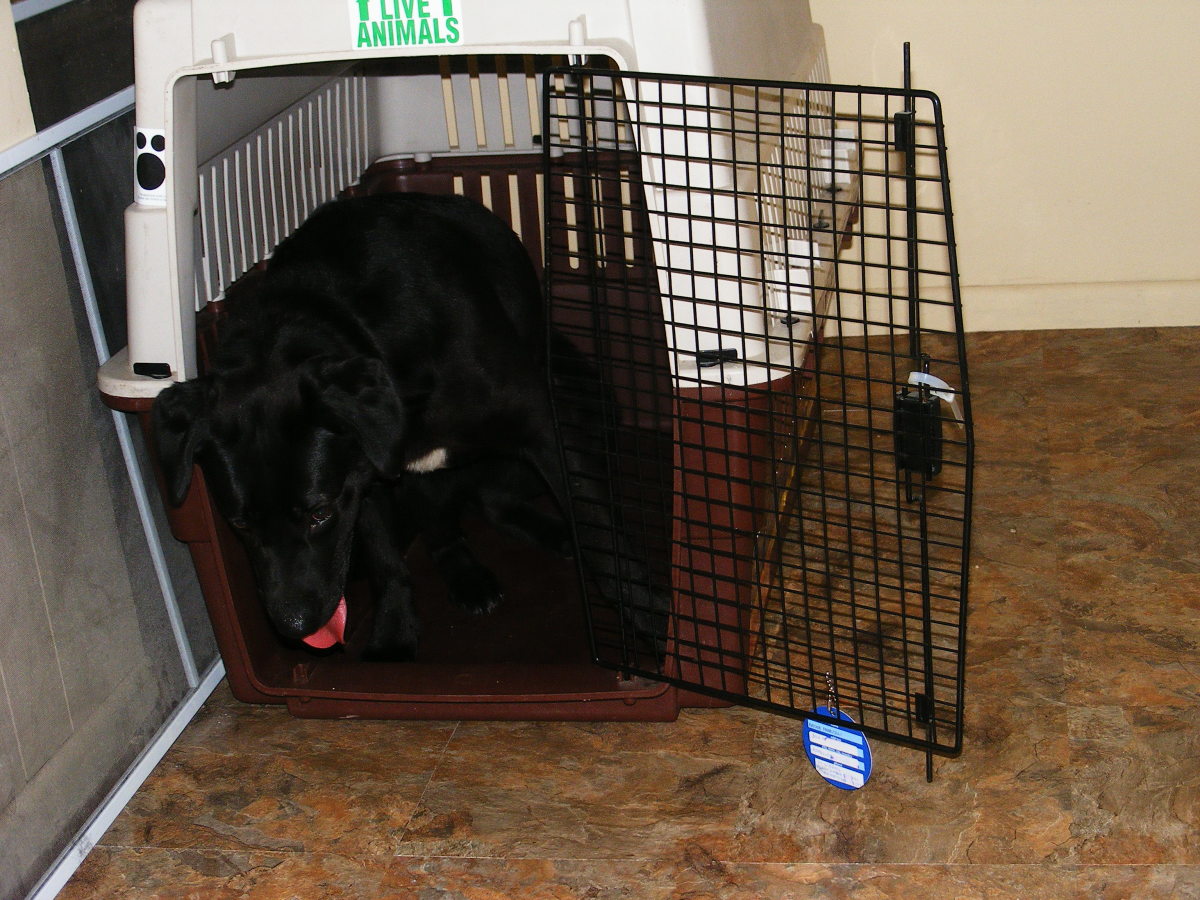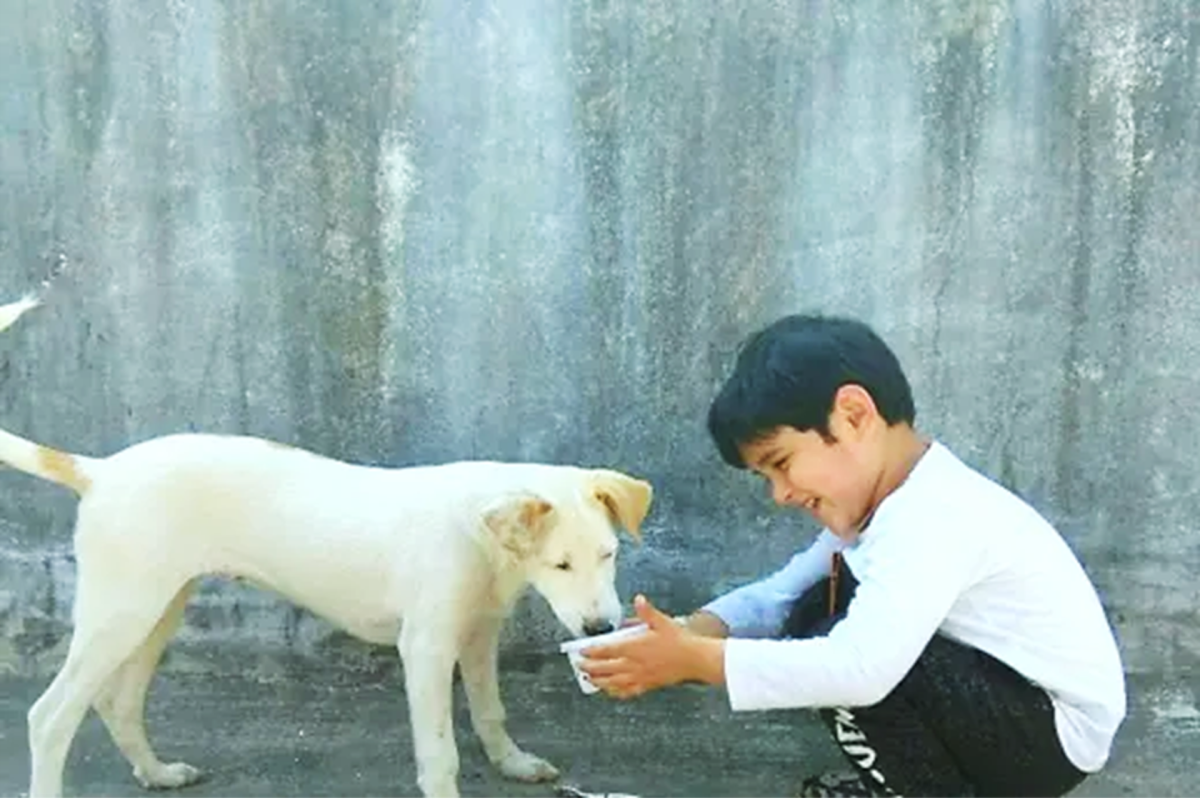Crate Training a Puppy: the Ins and Outs
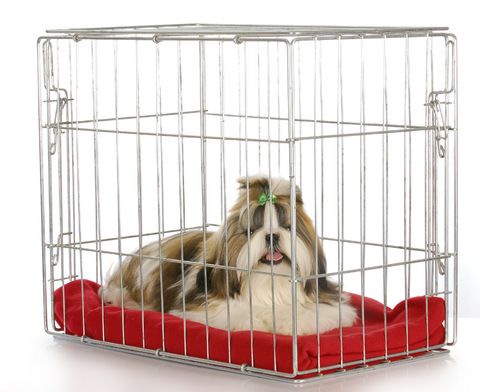
Introduction
Providing your puppy with a dog crate and training him to accept it is one of the most important (and rewarding) responsibilities of new dog ownership. Crate training provides multiple, mutual benefits to both puppy and owner. To the puppy, the crate represents a haven, a safe, comfortable and familiar place where he can sleep, eat, or go to escape when he feels tired or overwhelmed by family life. To the owner, it is a management tool that facilitates successful puppy raising in general and housebreaking in particular. It prevents the sorts of accidents and destruction that would otherwise have many a new puppy owner questioning his decision to get a puppy in the first place. To a person, a crate may look like a cage, and people often have negative associations with cages. Rest assured that with proper training and use, your puppy will see his crate not as a cage, but as a trusted sanctuary.
The first thing to know about crate training a puppy is that the crate needs to fit the puppy. Puppies are naturally loathe to soil their sleeping quarters, and with a properly sized crate, we can take advantage of this inclination and use it as an aid in housebreaking. The crate should be large enough for the puppy to stand up, turn around, and lie down comfortably. It should not be so large that he can make a bedroom of one end and a bathroom of the other! If you wish to avoid having to purchase more than one crate, Midwest makes a wire "life stages" crate that comes with a divider which can be removed as the puppy grows. Or, for a more rustic solution, purchase a crate that will be suitable when the puppy is full grown and put a couple of polar-fleece covered cinder-blocks in the back while he's still growing.
There are three primary types of crate that are commercially available from both online vendors and from livestock and pet supply stores. These are:
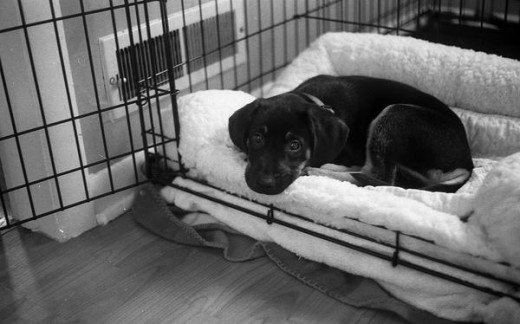
Wire Crates
Wire crates are produced by a variety of reputable companies such as Midwest, Precision, and Kennel-Aire. Wire crates are easy to clean (they typically have a metal or plastic tray that slides out from the bottom), and are collapsible for transportation and storage. They provide the most ventilation and visibility, which may or may not be an advantage, depending upon the dog, the season, and the location of the crate. Wire crates are easily covered, by either commercial covers or simply by a blanket, to create additional warmth and/or privacy, as needed. The disadvantages of wire crates are that they are the heaviest of the three types of crate, are not approved for airline travel, and many eventually become vulnerable to rust and to wire-to-wire bond breakage, which weakens the crate overall and leaves an exposed wire that, until repaired, is apt to snag coat, collars, and unwary fingers. Some wire crates have two doors, one on the end and another on the side.
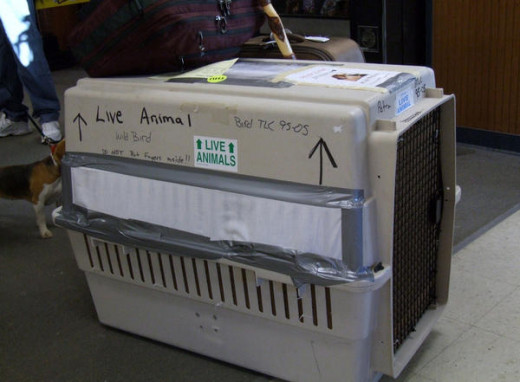
Plastic Crates
Plastic, or "airline" type crates come in two main pieces, a top and a bottom, with a gate, and are fastened along the side seam by one of several types of fasteners that range from dials that turn and click to lock, to specialty fasteners, to old fashioned nuts and bolts. Airlines typically reinforce these fastenings with heavy duty cable ties when shipping an animal. The best known plastic crate manufacturer is Pet Mate, who makes both the Vari-Kennel and Sky-Kennel lines. Remington is another recognized producer. Some models are sturdier than others and not all are airline approved, so if you're planning on flying with your dog, make sure in advance that the crate you purchase is approved for that purpose. Airline crates provide greater privacy for the dog (good for a dog that likes privacy, not so good for dogs that want to see everything that's going on), and are generally sturdy enough to last the lifetime of your dog. The drawbacks to a plastic crate is that it's bulkier to store, and to truly get one clean, it's necessary to a) crawl inside of it or b) take it apart.
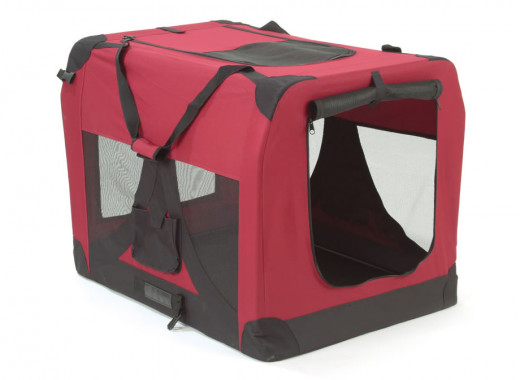
Soft Crates
Soft crates are usually made of heavy duty canvas or nylon, mesh and zippers. They typically will have some sort of lightweight aluminum frame and can be collapsed quickly and take very little room to store. There are many manufacturers: General Cage, Pet Gear, Mr. Herzher, Midwest, Precision, etc. Each brand of crate is a little different from the next. Some are easier to set up than others, some are lighter, some more durable, some have coverings that roll down over the "windows," some have rods that must be inserted while others have the rods built in. Take the time to study the differences. Look for heavy duty seams and zippers. Soft crates are for dogs who are already crate trained and past the puppy chewing phase. They are not recommended for anxious dogs or for those prone to separation anxiety.
Crate Training
Crate training is a breeze when you follow a few simple rules. The vast bulk of crate training can be accomplished within one day.
First, set the puppy up to succeed. Allow him to "discover" the crate. Place it in a room where people typically gather, and where you tend to spend the most time. Tie open the door to the crate to prevent accidental closing, bumping and banging. Outfit the crate with a cozy crate mat, a stuffed toy or two, and a chew toy. Drop in two or three small treats that you know the puppy enjoys, such as small cubes of cheese. Be sure to put one close to the entrance. Then, watch and wait for the puppy to find the treats on his own, and when he does, praise him profusely, especially if he ventures into the crate. When he's eaten all of the treats, show him another one and toss it inside the crate, praising him if he goes inside to get it. Periodically throughout the day, randomly drop another treat or two into the crate for the puppy to find. The idea is for all of his associations with the crate to be positive. If you are using a clicker or marker word to train him, use it any time the puppy ventures into the crate. At mealtime, feed him in the crate. Hopefully, when he gets tired, he'll choose the crate as his napping place, but if he doesn't, move him to it while he's asleep.
Next, when the puppy is comfortable eating and sleeping in the crate, untie the door. Show him how it moves. The next time he goes into the crate, shut the door for a few seconds, then open it and praise and treat him as if he did something wonderful. When you feed him, quietly close the door, and open it when he's through eating before he asks to be let out. Close it when he's napping, and when he awakes, open the door, again, anticipating his need and acting before he whines. Pick him up and take him immediately to go potty. Be vigilant about paying attention to when he's ready to come out. The goal is to condition him from the beginning to be quiet and content in the crate, and this is accomplished by anticipating his needs.
Finally, graduate to crating him for short periods of time (5-10 minutes), when he is awake but pleasantly tired. Over the next few days, slowly increase the amount of time he spends in the crate each session, and as his comfort level increases, begin to leave the room for a few minutes at the time. Always put in into the crate with a treat, but do not treat him upon your return if you leave the room. The idea is for him to develop the confidence and independence to stay alone, NOT to be eagerly anticipating your return and/or a treat. At night, bring the crate into the bedroom with you so that you can hear him if he needs to go potty during the night. Once he's old enough to sleep through the night, you should have little trouble leaving him in his crate in whatever area of the house you prefer.
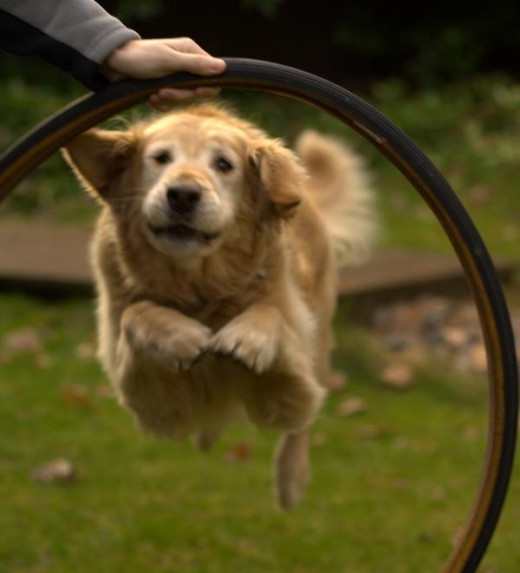
Dos and Don'ts
Do teach children that the puppy's crate is off limits to them when the puppy is in it. Teach them to respect the puppy's unspoken request for "space". Explain that he can't tell them when he's tired, but that when he goes into his crate, it is to have some time to himself. Do not let them poke or throw things into the crate, especially their fingers ... as it can be particularly dangerous habit for children to poke their fingers into a strange dog's crate.
Do always put the puppy into the crate with a treat.
If you have to be away for a lengthier period of time, do give him a chew toy or Kong to entertain himself with while you are away.
Do carry the puppy to go potty when taking him out of the crate first thing in the morning. If you expect him to walk, he is likely to have an accident along the way, at least while he's still a baby.
Do make every effort to "catch him doing something right" and to do all that is in your power to make him successful.
Do attach a cue word to the crate, such as "Go crate" or "Go to bed" that he will come to recognize.
Don't scold the puppy for any occasional accidents that might occur. Simply clean them up with an enzymatic cleanser such as Simple Solution or Nature's Miracle, and make a mental note to take him out sooner the next time. Dogs are clean by nature, and when you accustom them to clean quarters, they will eventually make the effort to keep them that way.
Don't force your puppy into the crate. Ever. You want all of his associations with the crate to be positive.
Don't use the crate as punishment.
Don't open the door when the puppy is whining to be let out. You must use your judgment here ... if he genuinely needs to go potty (say, the middle of the night) wait until he's quiet for at least a second or two. If you KNOW he does not need to go potty, but is whining simply because he wants out, it's permissible to lightly slap the side of the crate and say, "Eh-Eh! or "Wrong" or "No!" ... whatever your word is to let him know his behavior is not that which you desire.
Don't crate the puppy longer than he can reasonably hold his bladder. A general rule of thumb is to expect him to be able to hold his urine for one hour for every month of age he has obtained. Some dog's bladders are smaller than others, though, and this can vary.
Don't, as a general rule, give him water in his crate, except in circumstances where he must be crated for a long period of time, such as during the day while you work. Dogs do not need water in their crates at night, but be sure they have access to fresh water first thing in the morning. If you must leave water with the puppy in is crate, consider leaving it for him in a no spill bowl, or in the form or ice cubes. The more he drinks, the sooner he will need to go potty.
In Conclusion
Crate training encourages and creates the establishment of good habits, and good canine/human relationships are based on good habits. Crate training ensures the safety of both your puppy AND home, as it gives him a safe place to relax when you cannot be with him. It protects your lamp cords, furniture, carpets, and protects him from electrical burns, poisons, and falling objects. Most important of all, it both protects AND enhances your relationship, and that alone, is worth all the time and effort and time crate training takes, which actually, is quite minimal. Consider it a "relationship enhancement tool" and use it to better enjoy your new puppy!
Additional Dog and Puppy Training Articles
General Training Help:
The Top Five Dog Training Tips
Trick Training:
The Top Five Tricks to Teach Your Dog
Basic Obedience:
Dog Obedience: Teaching a Puppy to Come


